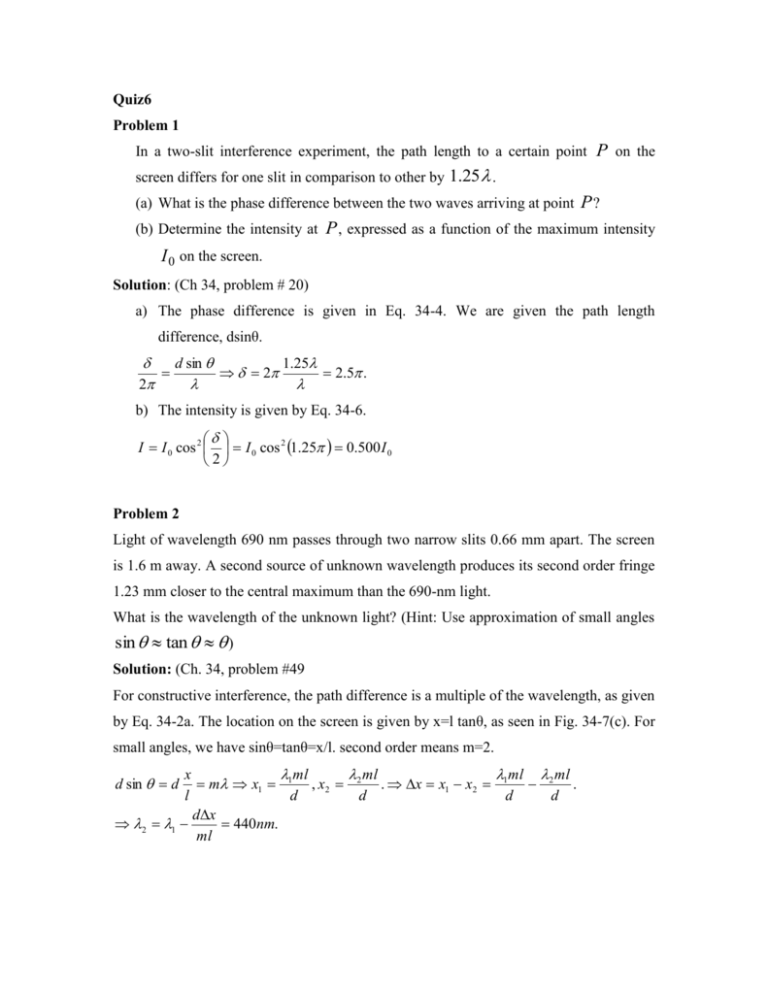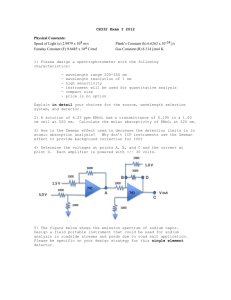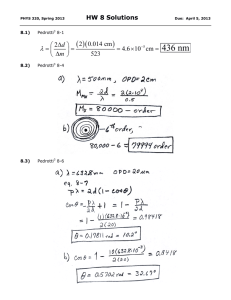Solution - UCSD Department of Physics
advertisement

Quiz6 Problem 1 In a two-slit interference experiment, the path length to a certain point P on the screen differs for one slit in comparison to other by 1.25 . (a) What is the phase difference between the two waves arriving at point P ? maximum intensity (b) Determine the intensity at P , expressed as a function of the I 0 on the screen. Solution: (Ch 34, problem # 20) a) The phase difference is given in Eq. 34-4. We are given the path length difference, dsinθ. d sin 1.25 2 2.5 . 2 b) The intensity is given by Eq. 34-6. I I 0 cos 2 I 0 cos 2 1.25 0.500 I 0 2 Problem 2 Light of wavelength 690 nm passes through two narrow slits 0.66 mm apart. The screen is 1.6 m away. A second source of unknown wavelength produces its second order fringe 1.23 mm closer to the central maximum than the 690-nm light. What is the wavelength of the unknown light? (Hint: Use approximation of small angles sin tan ) Solution: (Ch. 34, problem #49 For constructive interference, the path difference is a multiple of the wavelength, as given by Eq. 34-2a. The location on the screen is given by x=l tanθ, as seen in Fig. 34-7(c). For small angles, we have sinθ=tanθ=x/l. second order means m=2. ml ml ml ml x m x1 1 , x2 2 . x x1 x2 1 2 . l d d d d dx 2 1 440nm. ml d sin d Problem 3 One of the beams in Michelson interferometer passes through an evacuated glass container 42.5 cm long. Then the evacuated container is filled with chlorine gas, whose refractive index is 1.000772. If the interferometer uses light with wavelength 690 nm, how many bright fringes pass a fixed point as the container fills, assuming that the interferometer is in vacuum? Solution: Since the wavelength of the light in a gas ( gas vac ngas ) is shorter than in vacuum the number of the wavelength in the container with gas is larger than the number in the same container without gas. As a result, the phase shift is produced by the introduction of the gas. If difference in numberof wavelengths is 1, this results in one fringe shift. The light travels the length of the container twice, out and back. Thus, the number of fringes in the shift is 2 0.425 gas 2 0.425 vac (n gas 1)0.85 6.90 10 7 951











